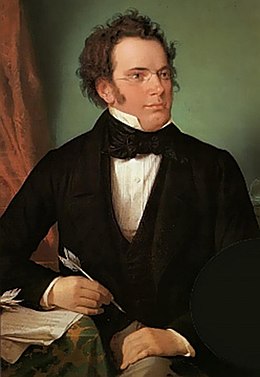Franz Schubert
![]()
Schubert is a redirect to this article. For other meanings, see Franz Schubert (disambiguation) and Schubert (disambiguation).
Franz Peter Schubert (born 31 January 1797 in the municipality of Himmelpfortgrund, now a district of Vienna in the Alsergrund district; † 19 November 1828 in Wieden, now also a district of Vienna) was an Austrian composer.
Although Franz Schubert died at the age of 31, he left behind a rich and varied body of work. He composed over 600 songs, secular and sacred choral music, seven complete and five unfinished symphonies, overtures, stage works, piano music and chamber music.
During his lifetime, the number of his admirers was still limited. Mendelssohn, Schumann, Liszt, Brahms and other Romantic composers discovered and praised the work of their predecessor. Today Schubert's rank as an outstanding representative of early Romanticism is undisputed.
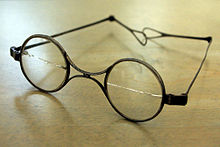
Schubert's glasses
Biography
Childhood
Franz Peter Schubert was born the thirteenth of his father's twenty children, only nine of whom reached adulthood. Schubert's father Franz Theodor (* 1763 in Neudorf in North Moravia, today Vysoká; † 9 July 1830) was a teacher and school principal. His mother Elisabeth Vietz (* 1756 in Zuckmantel, Austrian Silesia, today Zlaté Hory; † 28 May 1812) was a cook in a Viennese family before her marriage.
At the age of five Schubert received his first regular musical instruction: his father taught him to play the violin. At the age of six he went to school in the Viennese suburb of Lichtental. At the age of seven he was already receiving organ lessons from Michael Holzer, the bandmaster of the Lichtental parish church.
Because of his beautiful voice, he was accepted in October 1808 as a choirboy in the Vienna Hofmusikkapelle and in the imperial Konvikt. Schubert met many of his later long-time friends there - such as Joseph von Spaun, Albert Stadler and Anton Holzapfel. At the Konvikt, in addition to composition lessons from Wenzel Ruzicka and later Antonio Salieri, he enjoyed a wide range of musical stimulation. He was not only active as a soloist in singing, but also became acquainted with the instrumental works of Joseph Haydn and Wolfgang Amadeus Mozart, as he was the second violinist in the Konviktorchester.
Soon his talent in composition became apparent. A piano fantasy in G major for four hands is dated 8 April - 1 May 1810, followed the next year by a string quartet, another fantasy in G minor, songs and other pieces. On Sundays and holidays, string quartet evenings were regularly held in the family, with his father playing the violoncello, himself the viola, and his brothers the violin.
Youth
While his school performance was good at first, he deteriorated over time, especially in mathematics and Latin. He turned down the opportunity to extend his endowment and returned to the parental home in October 1813. At this time he composed his Symphony No. 1 in D major.
After attending a teacher training college, he became his father's school assistant at the end of 1814, a post he held for two years and again for a short time at the end of 1817 / beginning of 1818. In addition, he continued to receive lessons from Antonio Salieri until 1816 and composed prolifically: his first opera Des Teufels Lustschloß and his Mass No. 1 in F major (the premiere was on 25 September 1814 in the Lichtentaler concert hall). September 1814 in the Lichtental parish church was the first public performance of one of his works) both date from 1814, as do several string quartets, shorter instrumental works, the first movement of his Symphony No. 2 in B flat major, and more than twenty songs, including masterpieces such as Gretchen am Spinnrade (from Goethe's Faust) and interesting experiments such as the ballad Der Taucher (after Schiller).
He composed an even greater number of works in 1815. Despite his work as a teacher, he finished two symphonies (No. 2 in B-flat major, No. 3 in D major), two masses (No. 2 in G major, No. 3 in B-flat major), the operas Der vierjährige Posten, Fernando and Claudine von Villa Bella, and two more unfinished ones. In addition, there was the String Quartet in G minor, four sonatas and several other compositions for piano, as well as nearly 150 songs, some of considerable length, of which he sometimes wrote several per day.
Faced with the increasing incompatibility of his teaching position with composing, Schubert made numerous attempts to establish himself as a composer. But publishers refused to publish his works. In the spring of 1816 he applied unsuccessfully for the post of Kapellmeister in Ljubljana. Through his friend Joseph von Spaun he came into contact with Franz von Schober in Vienna. At the latter's suggestion, Schubert left his teaching position and moved into Schober's apartment for eight months in order to spend more time composing. Of the compositions from this year, only the Goethe ballad Erlkönig, the Prometheus Cantata, the two symphonies No. 4 in C minor (the "Tragic") and No. 5 in B flat major, as well as the Mass No. 4 in C major should be mentioned.
Throughout this time his circle of friends was constantly expanding. The poet Johann Mayrhofer, whom he had met in December 1814, wrote him two libretti. Schober introduced him to the baritone Johann Michael Vogl, one of the most important singers at the Vienna Court Opera, who soon sang his songs in the literary salons, thus introducing him to the public. The pianist Josef von Gahy played his sonatas and fantasies. The musical bourgeois family Sonnleithner, in particular their eldest son, Leopold von Sonnleithner, organised musical gatherings in his honour, which from 1821 onwards were known as Schubertiades (and still take place in a similar, but also completely differently organised form).
Together with Mayrhofer and Johann Chrysostomus Senn, Schubert also belonged to the Viennese fraternity circle ("Sennscher Kreis") around 1818/19, which was finally dissolved by the police in 1820.
Schubert had no real income, for he had given up his teaching position, public appearances brought in nothing, and publishers were not yet interested in his music. His friends had to provide for him in part. In a so-called nonsense society of young artists, he maintained close contacts with the Kupelwieser brothers, his later librettist Joseph Kupelwieser and the painter Leopold Kupelwieser, who - as one of few - painted authentic contemporary portraits of Schubert, alongside Wilhelm August Rieder (watercolour 1825) and Anton Depauly (whose portrait of 1828 was originally and erroneously attributed to Joseph Willibrord Mähler or Franz Eybl). When Schubert was first freed from teaching in 1817, he devoted himself in particular to piano sonatas (A minor D 537, A flat major D 557, E minor D 566, D flat major D 567, F sharp minor D 570, B flat major D 575). The composition of some of his best-known songs (such as Ganymede, Der Tod und das Mädchen and Die Forelle) also took place during this period.
Schubert's first composition, the song Erlafsee (D 586), appeared in print in January/January 1818 (as a supplement to the anthology edited by Franz Sartori "Mahlerisches Taschenbuch für Freunde interessanter Gegenden. Natur- und Kunst-Merkwürdigkeiten der Österreichischen Monarchie").
From the beginning of July to mid-November 1818 (and also in the summer of 1824) he was engaged by the family of Count Johann Carl Esterházy, whom he had already looked after musically in his city palace in Vienna, as a singing and piano master on their estate in Zselíz / Zelis in Hungary (today Slovakia). He wrote four-hand pieces and songs for the count's daughters Marie and Caroline. In the same year he wrote his Symphony No. 6 in C major.
On his return to Vienna in the late autumn of 1818, Schubert no longer stayed with Schober and now lived for two years with Johann Mayrhofer in his room. His life now resumed its old course: every morning he began composing after getting up, ate at two o'clock, went for a walk and then turned again to composition or visited friends. His decision against the teaching profession was now final.
He made his first appearance as a song composer on 28 February 1819 in the hall of the hotel "Zum römischen Kaiser" (Freyung No. 145, today Renngasse 1) with Schäfer's lament. In the summer of the same year he went on vacation with Vogl in Upper Austria. In autumn he sent three of his songs to Goethe, but - as far as is known - without success.
Maturity years
In the following years, Schubert's output declined in quantity, but the compositions of 1820 show a further development of his style. In February he began with the unfinished oratorio Lazarus, and later, in addition to smaller pieces, he wrote a setting of the 23rd Psalm for choir with piano accompaniment, the Gesang der Geister and the quartet movement in C minor.
Two of Schubert's operas were performed for the first time this year: the one-act Singspiel Die Zwillingsbrüder on 14 June at the Theater am Kärntnertor and Die Zauberharfe on 19 August at the Theater an der Wien. Until then, his larger compositions - with the exception of the masses - had not progressed beyond the amateur orchestra at the Gundelhof, which had emerged from the domestic quartet events. Since both pieces were passable successes, he was now able to address a wider audience. But it was not until Vogl had sung the Erlkönig in a public concert that the publisher Anton Diabelli could be persuaded to publish some of Schubert's works on commission.
In 1821 his friendship with Moritz von Schwind began. Schubert again lived for a time with his friend Franz von Schober, for example in 1822 at the Göttweiger Hof, where, among other works, the Unfinished and the Wanderer Fantasy were written. Schubertiades took place among his friends, among others in the Lower Austrian castle Atzenbrugg, where Schober's uncle was estate manager. Several poem settings, such as Jäger's Liebeslied, refer to the friendship with Schober.
As with Schubert's relationship with Mayrhofer, various documents and a detailed analysis of the work by Christoph Schwandt also point to a homosexual relationship.
In 1821/22 Schubert earned about 800 fl. convention money from the publication of Opus 1-7 and 10-12. As a school assistant, he had received only 80 fl. annually from his father in addition to room and board. Otto Erich Deutsch estimated Schubert's further income from publications, fees and gifts between 1822 and 1828 at about 7000 fl. convention coin.
Encouraged by his successes, Schubert now tried to establish himself as a stage composer, but his hopes were disappointed. Both Alfonso und Estrella - composed between September 1821 and February 1822 - and Die Verschworenen nach Ignaz Franz Castelli (April 1823) were rejected by the theatre, and Fierrabras (autumn 1823) was cancelled after initial rehearsals. The incidental music for Helmina von Chézy's Rosamunde was well received, but the play itself was cancelled after two evenings.
Schubert's state of health gave rise to speculation. With increasing age he became more corpulent and was prone to alcoholic excesses. The first authentically recorded illness struck him in December 1822, and although a stay in hospital in the autumn of 1823 brought improvement, by the following spring the illness seems to have placed a particularly heavy psychological burden on the composer ("I feel myself to be the most unhappy, miserable person in the world" he wrote to Leopold Kupelwieser). According to the current view of Schubert research, Schubert had contracted a venereal disease at that time, probably syphilis, since he was hospitalized in January 1823 for syphilitic ulcers.
Various legends circulate about Schubert's lifestyle during this period. It is said, for example, that Schubert spent most of the money he earned from teaching or selling compositions on evenings with friends in the old Viennese inns, which did not exactly help his reputation. According to an unconfirmed anecdote, the innkeeper even occasionally took a song in payment, which Schubert often composed right at the inn table when he was unable to pay the bill in cash. It is also said about Schubert's eagerness to work that he always kept his usual eyeglasses on at night so that he could begin composing in the morning without losing any time.
Despite his preoccupation with the stage and later with his official duties, he found time during these years for many other compositions. In 1822 the Mass No. 5 in A-flat major was finished and the Symphony in B minor begun. His first famous song cycle, Die schöne Müllerin, dates from 1823, the Variations on Trockne Blumen and two string quartets in A minor (Rosamunde) and D minor (Der Tod und das Mädchen) from 1824.
In the spring of 1824 he wrote his Octet in F major. From the end of May to mid-October 1824 he was engaged for the second time in Zelis. He dedicated the three songs "Ungeduld" (Impatience), "Morgengruß" (Morning Greeting) and "Des Müllers Blumen" (The Miller's Flowers) from the Schönen Müllerin to the 19-year-old Comtesse Caroline Esterházy. There Schubert also noted the two-hand Mélodie hongroise D 817 and worked it out in the finale of the four-hand Divertissement à la Hongroise D 818, which was probably written after his return from Zelis. The four-hand piano sonata D 812, the Grand Duo, was also written in Zelis. At the suggestion of Countess Rosine Esterházy, he set Friedrich de la Motte Fouqué's "Prayer" to music as a vocal quartet.
In 1825 Schubert once again had a happier phase, during which he travelled through the Archduchy of Austria above the Enns (with the Salzburg district) to Bad Gastein for a cure. There and in Gmunden he worked on what later became known as the Gmunden-Gastein Symphony and wrote his Piano Sonata in D major (D 850); probably shortly before, he had already written the Piano Sonata in A minor (D 845), which he was able to publish at a rather high price. He became friends with Eduard von Bauernfeld. Furthermore, he cultivated his contacts with Anselm Hüttenbrenner and Johann Baptist Jenger, his friends in Styria.
· 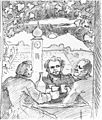
Franz Lachner (left), Schubert and Eduard von Bauernfeld at the Heurigen (Moritz von Schwind, 1862)
· 
Jenger, Hüttenbrenner and Schubert, lithograph by Josef Teltscher, 1827
The last years
From 1826 to 1828 Schubert stayed in Vienna and its suburbs - apart from a brief stay in Graz at the home of Marie Pachler-Koschak. The position of Vice-Kapellmeister at the Imperial Court Chapel, for which he applied in 1826, was not awarded to him, but to Joseph Weigl. On March 26, 1828, he gave the only public concert of his career, which brought him 800 florins of Viennese currency (320 fl. convention coin). Numerous songs and piano works had been printed in the meantime.
He wrote the final version of the String Quartet in D minor with the variations on Der Tod und das Mädchen during the winter of 1825/1826. This was followed in 1826 by the String Quartet in G major, the Rondeau brillant for piano and violin, the Piano Sonata in G major and Schubert's best-known sacred work, the German Mass.
In 1827 he composed the song cycle Winterreise, the Impromptus, the Fantasy for piano and violin and the two piano trios in B flat major and E flat major. In 1828 he wrote the Mass No. 6 in E-flat major, the String Quintet in C major (D 956), the last three piano sonatas (D 958-960), which belong together, and a collection of songs which was published after his death and called Schwanengesang. He also sketched three movements for a symphony in D major.
Death
After two weeks of continuous fever, Franz Schubert died on 19 November 1828 at 3 o'clock in the afternoon in the apartment of his brother Ferdinand Schubert in the house "Auf der neuen Wieden N° 694" (today Kettenbrückengasse 6 in the Wieden district). He was still suffering from syphilis, which had not been cured, but the cause of death was probably an acute infectious disease, probably typhus. This disease was called "nervous fever" at that time.
Schubert was buried in the Währinger Cemetery near Ludwig van Beethoven's grave. In 1888 his remains were transferred to a grave of honour at the Vienna Central Cemetery (group 32 A, number 28).
· 
Schubert's death house (Kettenbrückengasse 6, Vienna IV)
· 
Schubert's death house, watercolour by F. Kopallick
· 
First grave next to Beethoven's in the cemetery at Währing, portrait bust by Josef Alois Dialer
·
First graves of Beethoven and Schubert in Währing
_-_Schuberthaus_(1).JPG)
Birthplace at Himmelpfortgrund, today Nußdorfer Straße 54
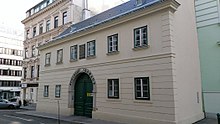
From 1801 the Schubert family lived in Säulengasse 3 in the suburb Himmelpfortgrund
_-_Lichtentaler_Kirche.jpg)
Schubert was baptized in the Lichtental parish church

Young Schubert (Josef Abel)

Schubertiade, known under the title Ein Schubert-Abend bei Joseph von Spaun, with Franz Schubert at the piano (sepia drawing by Moritz von Schwind, 1868, Wien Museum, Vienna)
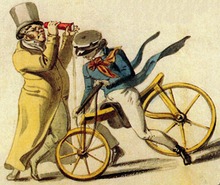
Schubert and Kupelwieser in the nonsense society
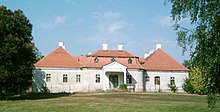
Country estate of the Esterházy family in Zselíz
.jpg)
Franz Schubert among friends , drawing by Ferdinand Georg Waldmüller, Albertina Vienna.

Memorial plaque at the Göttweiger Hof in Spiegelgasse

Schubert on 10 July 1821, portrait drawing by Leopold Kupelwieser
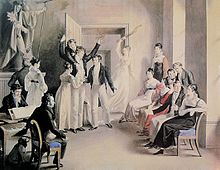
Franz Schubert at the piano, watercolour by Leopold Kupelwieser (The Fall of Man, 1821, Wien Museum, Vienna).
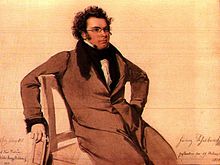
Franz Schubert in May 1825, heliogravure after the watercolour by Wilhelm August Rieder, signed below by Rieder and Schubert

Franz Schubert's face mask. It is disputed whether it is a death mask or a living mask.
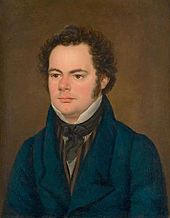
Franz Schubert, painted around 1827 by Anton Depauly
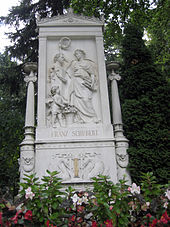
Grave of honour erected in 1888 at the Vienna Central Cemetery, design: Theophil Hansen
Honors
In 1869 Moritz von Schwind created a Schubert lunette with motifs from Schubert's works in the new k.k. Court Opera House in Vienna a Schubert lunette with motifs from works by Schubert. In 1872 a monument designed by Carl Kundmann was erected in Schubert's memory in the Vienna City Park.
The Schubert Year 1928 was celebrated in Austria on a grand scale; countless monuments, commemorative plaques and Schubert lime trees were unveiled in towns, markets and villages throughout Austria, mostly with the inscription "Dem deutschen Liederfürsten Franz Schubert".
Due to Schubert's great popularity, numerous traffic areas were named after him. In Vienna, these are still the Schubertring in the 1st district (Innere Stadt), the Schubertgasse in the 9th district (Alsergrund), the Franz-Schubert-Straße in the 14th district (Penzing) and the Franz-Schubert-Weg in the 18th district (Währing). Before the respective incorporation into Vienna (1890/1892 and 1938) there were also Schubert streets in Ottakring (today: Dampfbadgasse), Atzgersdorf (today: Vertexgasse), Erlaa (today: Welingergasse) and Liesing (today: Josef-Bühl-Gasse) as well as Schubert streets in Oberlaa (today: Hasenöhrlstraße) and Essling (today: Ibachstraße). Furthermore, there are Schubertgassen, Schubertstraßen, Schubertplätze, Schubertwege, Schubertalleen and Schubertringe in very many Austrian and German communities.
A large impact crater on the planet Mercury is named after Franz Schubert. The same applies to Schubert Inlet, a bay on the coast of West Antarctica's Alexander I Island.
· 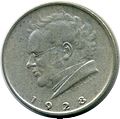
Austrian 2 Shilling Coin (1928)

Schubert Monument in the Vienna City Park
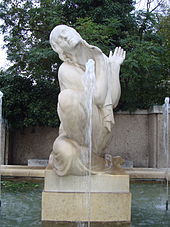
Schubert Fountain in the Viennese district Alsergrund
Questions and Answers
Q: Who was Franz Peter Schubert?
A: Franz Peter Schubert was an Austrian composer who was born in Vienna in 1797.
Q: How many pieces of music did Schubert compose?
A: Schubert composed over one thousand pieces of music.
Q: Were there any other great composers who lived and worked in Vienna?
A: Yes, there were other great composers who lived and worked in Vienna. These include Haydn, Mozart and Beethoven.
Q: Who was the only one among the great composers born in Vienna?
A: Franz Schubert was the only one among the great composers who was born in Vienna.
Q: What is Schubert's role in music history?
A: Schubert was the last great composer of the Classical music period, and one of the first of the Romantic period.
Q: When did Schubert die?
A: Schubert died on 19 November 1828 in Vienna.
Q: How old was Schubert when he died?
A: Schubert died at the age of 31.
Search within the encyclopedia
